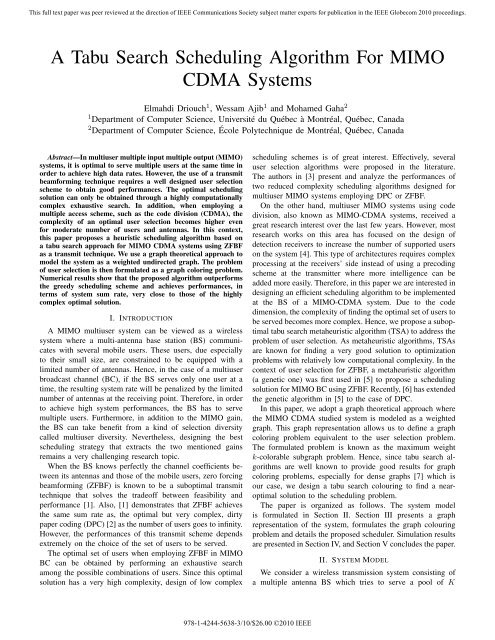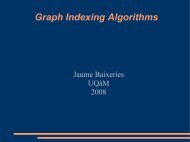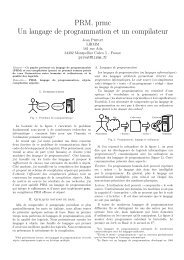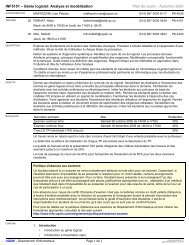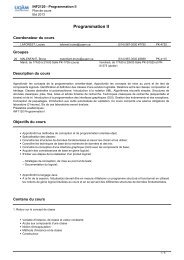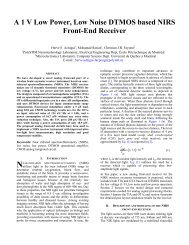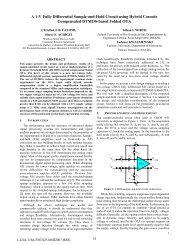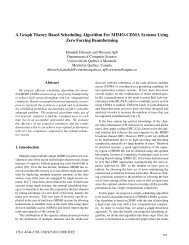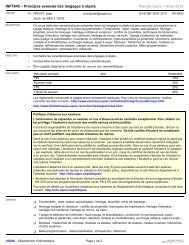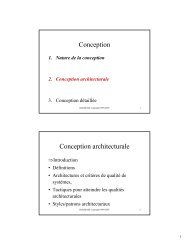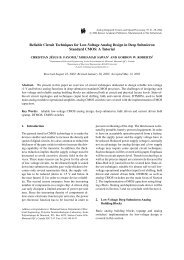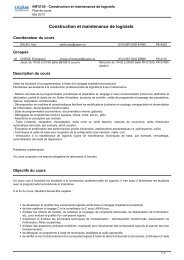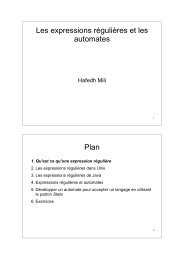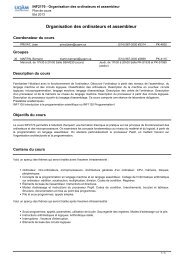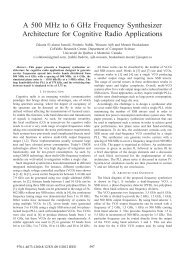A Tabu Search Scheduling Algorithm For MIMO ... - IEEE Xplore
A Tabu Search Scheduling Algorithm For MIMO ... - IEEE Xplore
A Tabu Search Scheduling Algorithm For MIMO ... - IEEE Xplore
Create successful ePaper yourself
Turn your PDF publications into a flip-book with our unique Google optimized e-Paper software.
This full text paper was peer reviewed at the direction of <strong>IEEE</strong> Communications Society subject matter experts for publication in the <strong>IEEE</strong> Globecom 2010 proceedings.<br />
A <strong>Tabu</strong> <strong>Search</strong> <strong>Scheduling</strong> <strong>Algorithm</strong> <strong>For</strong> <strong>MIMO</strong><br />
CDMA Systems<br />
Elmahdi Driouch 1 , Wessam Ajib 1 and Mohamed Gaha 2<br />
1 Department of Computer Science, Université duQuébec à Montréal, Québec, Canada<br />
2 Department of Computer Science, École Polytechnique de Montréal, Québec, Canada<br />
Abstract—In multiuser multiple input multiple output (<strong>MIMO</strong>)<br />
systems,itisoptimaltoservemultipleusersatthesametimein<br />
order to achieve high data rates. However, the use of a transmit<br />
beamforming technique requires a well designed user selection<br />
scheme to obtain good performances. The optimal scheduling<br />
solution can only be obtained through a highly computationally<br />
complex exhaustive search. In addition, when employing a<br />
multiple access scheme, such as the code division (CDMA), the<br />
complexity of an optimal user selection becomes higher even<br />
for moderate number of users and antennas. In this context,<br />
this paper proposes a heuristic scheduling algorithm based on<br />
a tabu search approach for <strong>MIMO</strong> CDMA systems using ZFBF<br />
as a transmit technique. We use a graph theoretical approach to<br />
model the system as a weighted undirected graph. The problem<br />
of user selection is then formulated as a graph coloring problem.<br />
Numerical results show that the proposed algorithm outperforms<br />
the greedy scheduling scheme and achieves performances, in<br />
terms of system sum rate, very close to those of the highly<br />
complex optimal solution.<br />
I. INTRODUCTION<br />
A <strong>MIMO</strong> multiuser system can be viewed as a wireless<br />
system where a multi-antenna base station (BS) communicates<br />
with several mobile users. These users, due especially<br />
to their small size, are constrained to be equipped with a<br />
limited number of antennas. Hence, in the case of a multiuser<br />
broadcast channel (BC), if the BS serves only one user at a<br />
time, the resulting system rate will be penalized by the limited<br />
number of antennas at the receiving point. Therefore, in order<br />
to achieve high system performances, the BS has to serve<br />
multiple users. Furthermore, in addition to the <strong>MIMO</strong> gain,<br />
the BS can take benefit from a kind of selection diversity<br />
called multiuser diversity. Nevertheless, designing the best<br />
scheduling strategy that extracts the two mentioned gains<br />
remains a very challenging research topic.<br />
When the BS knows perfectly the channel coefficients between<br />
its antennas and those of the mobile users, zero forcing<br />
beamforming (ZFBF) is known to be a suboptimal transmit<br />
technique that solves the tradeoff between feasibility and<br />
performance [1]. Also, [1] demonstrates that ZFBF achieves<br />
the same sum rate as, the optimal but very complex, dirty<br />
paper coding (DPC) [2] as the number of users goes to infinity.<br />
However, the performances of this transmit scheme depends<br />
extremely on the choice of the set of users to be served.<br />
The optimal set of users when employing ZFBF in <strong>MIMO</strong><br />
BC can be obtained by performing an exhaustive search<br />
among the possible combinations of users. Since this optimal<br />
solution has a very high complexity, design of low complex<br />
scheduling schemes is of great interest. Effectively, several<br />
user selection algorithms were proposed in the literature.<br />
The authors in [3] present and analyze the performances of<br />
two reduced complexity scheduling algorithms designed for<br />
multiuser <strong>MIMO</strong> systems employing DPC or ZFBF.<br />
On the other hand, multiuser <strong>MIMO</strong> systems using code<br />
division, also known as <strong>MIMO</strong>-CDMA systems, received a<br />
great research interest over the last few years. However, most<br />
research works on this area has focused on the design of<br />
detection receivers to increase the number of supported users<br />
on the system [4]. This type of architectures requires complex<br />
processing at the receivers’ side instead of using a precoding<br />
scheme at the transmitter where more intelligence can be<br />
added more easily. Therefore, in this paper we are interested in<br />
designing an efficient scheduling algorithm to be implemented<br />
at the BS of a <strong>MIMO</strong>-CDMA system. Due to the code<br />
dimension, the complexity of finding the optimal set of users to<br />
be served becomes more complex. Hence, we propose a suboptimal<br />
tabu search metaheuristic algorithm (TSA) to address the<br />
problem of user selection. As metaheuristic algorithms, TSAs<br />
are known for finding a very good solution to optimization<br />
problems with relatively low computational complexity. In the<br />
context of user selection for ZFBF, a metaheuristic algorithm<br />
(a genetic one) was first used in [5] to propose a scheduling<br />
solution for <strong>MIMO</strong> BC using ZFBF. Recently, [6] has extended<br />
the genetic algorithm in [5] to the case of DPC.<br />
In this paper, we adopt a graph theoretical approach where<br />
the <strong>MIMO</strong> CDMA studied system is modeled as a weighted<br />
graph. This graph representation allows us to define a graph<br />
coloring problem equivalent to the user selection problem.<br />
The formulated problem is known as the maximum weight<br />
k-colorable subgraph problem. Hence, since tabu search algorithms<br />
are well known to provide good results for graph<br />
coloring problems, especially for dense graphs [7] which is<br />
our case, we design a tabu search colouring to find a nearoptimal<br />
solution to the scheduling problem.<br />
The paper is organized as follows. The system model<br />
is formulated in Section II. Section III presents a graph<br />
representation of the system, formulates the graph colouring<br />
problem and details the proposed scheduler. Simulation results<br />
are presented in Section IV, and Section V concludes the paper.<br />
II. SYSTEM MODEL<br />
We consider a wireless transmission system consisting of<br />
a multiple antenna BS which tries to serve a pool of K<br />
978-1-4244-5638-3/10/$26.00 ©2010 <strong>IEEE</strong>
This full text paper was peer reviewed at the direction of <strong>IEEE</strong> Communications Society subject matter experts for publication in the <strong>IEEE</strong> Globecom 2010 proceedings.<br />
users. We assume that the BS is equipped with M transmit<br />
antennas, whereas each user has only single antenna. The<br />
channel coefficients between the BS transmit antennas and<br />
the users’ antennas are modeled as independent identically<br />
distributed (i.i.d.) complex Gaussian variables with zero mean<br />
and unit variance. We consider that time is divided into slots.<br />
The channel coefficients are assumed to be constant during<br />
the entire slot but may change from one slot to another.<br />
We assume that data is always available, at the BS, ready to<br />
be transmitted to the scheduled users. Therefore, the scheduling<br />
decision is isolated from the effect of data arrival. Let h k<br />
denote the channel coefficients M × 1 vector between the BS<br />
transmit antennas and user k antenna. It is assumed that the<br />
BS perfectly knows the channel vectors for all users.<br />
Since we assume the use of CDMA as a multiple access<br />
technique, the BS makes use of N spreading code. At each<br />
time slot, the BS must select a given number of users to be<br />
served. The scheduled users are then disposed in at most N<br />
(same as the number of available codes) distinct sets; denoted<br />
by ζ n ,(n =1,...,N). Each scheduled set of users is then<br />
served using the same code denoted by the 1 × C vector c n<br />
where C represents the processing gain. The used spreading<br />
codes are a combination of orthogonal codes and pseudorandom<br />
noise (PN) codes. Note that we use this combination<br />
to improve the correlation properties of the signals.<br />
We denote by S n the M × C matrix of the chip-level<br />
transmitted signals from the BS to the users belonging to<br />
the set ζ n . In fact, each user’s signal is first spread using<br />
the corresponding spreading code. The resulting signal is then<br />
multiplied by a precoding vector before transmission.<br />
S n = ∑ k∈ζ n<br />
√<br />
Pk w k c n x k (1)<br />
where P k is the power allocated to user k, w k is the M × 1<br />
precoding vector and x k is the transmitted data symbol for the<br />
k th user.<br />
The BS has a limited amount of power to allocate to the<br />
scheduled users at each timeslot denoted by P . Also, P n<br />
denotes the portion of the total power P that the BS allocates<br />
to the users belonging to the set ζ n . Then, we have<br />
N∑ N∑ ∑<br />
P = P n = P k . (2)<br />
n=1 n=1 k∈ζ n<br />
Therefore, the chip-level sampled signal 1 × C vector y k ,<br />
for this user is given by:<br />
√<br />
y k = h T k Pk w k c n x k +<br />
∑ √<br />
h T k Pj w j c n x j<br />
+<br />
N∑<br />
j∈ζ n,j≠k<br />
∑<br />
h T k<br />
l=1, l≠n j∈ζ l<br />
√<br />
Pj w j c l x j + z k (3)<br />
where z k is the 1 × C vector representing the i.i.d. additive<br />
white complex Gaussian noise with zero mean and unit<br />
variance.<br />
In order to totally eliminate the interference between the<br />
users using the same spreading code, we assume that the BS<br />
makes use of ZFBF as a precoding scheme. Hence, the interference<br />
among the users sharing the same code, represented by<br />
the second term in (3), is eliminated through ZFBF. Whereas,<br />
the interference produced by the users in the other sets (the<br />
third term in (3)) is limited since we use CDMA. Note that<br />
ZFBF limits the number of users that can be scheduled in a<br />
set to the number of antennas M, i.e. Card(ζ n )
This full text paper was peer reviewed at the direction of <strong>IEEE</strong> Communications Society subject matter experts for publication in the <strong>IEEE</strong> Globecom 2010 proceedings.<br />
P k,opt =(μ/‖w (k)<br />
ζ n<br />
‖ 2 − 1) + (8)<br />
where μ is the solution of the equation given as follows:<br />
N∑ ∑<br />
n=1<br />
k∈ζ n<br />
(μ −‖w (k)<br />
ζ n<br />
‖ 2 )=P (9)<br />
III. THE ZFBF <strong>MIMO</strong> CDMA TABU SEARCH<br />
ALGORITHM (TABU-ZFBF-MC)<br />
In this section, we first formulate the scheduling problem as<br />
a graph colouring problem. Then, we present a low complexity<br />
metaheuristic algorithm based on the well-known tabu search<br />
approach.<br />
A. Graph Representation<br />
We first present a graph representation of the <strong>MIMO</strong> CDMA<br />
system. The resulting graph G =(V,E), where V is the set of<br />
vertices and E is the set of edges, is called the system graph<br />
and it can be obtained as follows [9]: Each user k in the system<br />
is represented by a vertex v k and we assign to each vertex a<br />
non-negative weight given by its correspending channel gain<br />
‖h k ‖ 2 . Furthermore, there is an edge (v i ,v j ) between vertices<br />
v i and v j if and only if<br />
e ij = |h ih j |<br />
>ɛ, (10)<br />
‖h i ‖‖h j ‖<br />
i.e. their channels are not ɛ-orthogonal where ɛ is a constant<br />
denoting the orthogonality threshold.<br />
Note that the value of the parameter ɛ has a direct impact<br />
on the performances of the system. In fact, since the selected<br />
users in each set are not perfectly orthogonal, the scheduling<br />
decision will not be always optimal introducing some rate loss<br />
influenced by the chosen value of ɛ. Anyhow, we use a nearoptimal<br />
value of ɛ found by simulations.<br />
B. Graph Problem <strong>For</strong>mulation<br />
Let us consider a graph G = (V,E) similar to the one<br />
defined earlier where every vertex v in V is assigned a non<br />
negative weight γ v . We consider also an integer number<br />
k>0. We define the maximum weight k-colorable subgraph<br />
problem as finding a subgraph G ′ = V ′ ⊂ V,E ′ of the graph<br />
G, such that there exists a vertex coloring C V ′<br />
∑<br />
of G ′ with<br />
k colors that maximizes the value among all the<br />
v∈V ′ γ v<br />
possible subgraphs. Such a problem can be typically given<br />
by the following mathematical formulation:<br />
Find V ′ ⊆ V<br />
such that ∃C V ′<br />
with k colors and max<br />
V ′<br />
∑<br />
i∈V ′ γ i<br />
It has been shown in [10] that this problem is NP-hard.<br />
The scheduling algorithm have the mission of choosing the<br />
scheduled users disposed in a given number of sets. Therefore,<br />
finding the best sets of users for a <strong>MIMO</strong> CDMA system using<br />
ZFBF can be seen as the problem of finding a solution to<br />
the maximum weight k-colorable subgraph problem having as<br />
input the system graph and the number of available spreading<br />
codes which corresponds to the number of colors to use.<br />
C. A <strong>Tabu</strong> <strong>Search</strong> <strong>Algorithm</strong> (<strong>Tabu</strong>-ZFBF-MC)<br />
[7] was the first work that adapts the tabu search technique<br />
to the problem of graph colouring (TABUCOL). The proposed<br />
algorithm gives good solutions and outperforms several<br />
heuristics especially in the case of dense graphs. In this paper,<br />
we develop a solution to the maximum weight k-colorable<br />
subgraph problem based on a tabu search approach.<br />
In order to adapt tabu search metaheuristics to solve a given<br />
problem, the developed algorithm has to:<br />
• construct an initial solution,<br />
• define moves that determine the neighbors of a solution,<br />
• decide of the content and size of tabu list, and finally,<br />
• design diversification mechanisms.<br />
The tabu search ends when one of the following two<br />
conditions occurs.<br />
• The maximal number of allowed iterations has been<br />
reached.<br />
• The maximal number of iterations, where the best solution<br />
is not enhanced successively, has been reached.<br />
In the following, we detail how we adapt the tabu search<br />
metaheuristic steps in order to solve the problem of user<br />
scheduling in ZFBF based <strong>MIMO</strong> CDMA systems.<br />
1) Initial Solution: Given a system graph G =(V,E) and<br />
a number of colors k (which corresponds also to the number<br />
of available spreading codes), the first step of a tabu search<br />
is to find an initial solution to the algorithm. Remember that<br />
the initial solution must be feasible, i.e. the initial k-colouring<br />
must be legal respecting the constraints of graph colouring. We<br />
propose two ways to construct the initial k-colouring: random<br />
colouring and greedy colouring. The random colouring assign<br />
a different color to a user picked randomly while keeping the<br />
colouring legal. Whereas, the greedy colouring runs the greedy<br />
algorithm proposed in [9] to find an initial solution. Though<br />
the greedy colouring gives a better initial solution, we use the<br />
random colouring due to its lower complexity.<br />
2) Move Definition: The definition of the neighborhood<br />
Ne(s) of the current solution s is a crucial step since it has<br />
an impact on the quality of the final solution. Note that s<br />
represents the current k-colouring of the graph. In this paper,<br />
we generate a neighbour s ′ of the current solution s as follows:<br />
we choose a non-coloured vertex v i . Then we compute the sum<br />
weights for each possible colouring of v i . Colouring v i with a<br />
given color assumes decolouring its adjacent vertices having<br />
the same color. Hence, each move is represented by a pair<br />
(v i ,c n ) with n =1,...,N.<br />
Having generated all the possible moves, excluding obviously<br />
tabu moves, we pick up the best one (the one improving<br />
the sum weights) and we move to it.<br />
3) <strong>Tabu</strong> List: The tabu list is obtained as follows. Whenever<br />
an initially non-coloured node v i takes a color c n to get the<br />
new solution, the pair (v i ,c n ) is added to the tabu list, i.e.<br />
if the v i looses its color then it can not be coloured by c n<br />
978-1-4244-5638-3/10/$26.00 ©2010 <strong>IEEE</strong>
This full text paper was peer reviewed at the direction of <strong>IEEE</strong> Communications Society subject matter experts for publication in the <strong>IEEE</strong> Globecom 2010 proceedings.<br />
<strong>Algorithm</strong> 1: The ZFBF <strong>MIMO</strong>-CDMA <strong>Tabu</strong> <strong>Search</strong><br />
Input:<br />
Itermax = maximum number of iterations<br />
G =(V,E)<br />
k = number of colors (codes)<br />
|T | = size of the tabu list<br />
Initialization:<br />
Generate a random legal k-colouring<br />
Initialize the tabu list T<br />
Iter ← 0<br />
Bad move ← 0<br />
Change ← true<br />
while Iter < Itermax do<br />
for each non coloured vertex v i do<br />
Generate possible non taboo moves<br />
Update the coloring:<br />
Step1: Choose the best move: (v i ,c n) the one that improves<br />
the sum weights (assuming always a legal k-coloring)<br />
Step2: Colour v i with color c n (Put user v i in the set c n)<br />
Step3: Decolour the adjacent vertices of v i already coloured<br />
by c n<br />
Step4: Update T : introduce (v i ,c n) and remove the oldest<br />
tabu move<br />
if the colouring is updated then<br />
Change ← true<br />
Best Colouring ← Current Colouring<br />
end<br />
end<br />
if Change = false then<br />
Take the best move in the current iteration (in spite if it<br />
doesn’t improve the sum weight)<br />
Bad move ← Bad move +1<br />
end<br />
if Bad move = Allowed bad moves then<br />
Diversification<br />
end<br />
Iter ← Iter +1<br />
end<br />
Output: The sets of users to be served are given by the sets in<br />
Best Coulouring<br />
for a given number of iterations. Note that each time a new<br />
pair (vertex, color) is added to the tabu list, the oldest pair is<br />
removed from the list.<br />
4) Diversification: Diversification is a mechanism that<br />
permits to improve a tabu search method. In the proposed<br />
algorithm, we allow sometimes a move that does not improve<br />
the current solution. Such a move is considered as a bad<br />
move. When the number of bad moves reaches a certain fixed<br />
threshold, we perform diversification. In fact, in order to get<br />
out from a local maximum, a random k-colouring, like the one<br />
that constructs the initial random solution, is performed.<br />
The complete formulation of the tabu search algorithm that<br />
solves the user selection problem is given by <strong>Algorithm</strong> 1.<br />
IV. SIMULATION RESULTS<br />
In this section, we analyze the performance of the proposed<br />
tabu search algorithm in terms of the maximum achievable<br />
throughput. The simulations are performed for a relatively<br />
simple system with four spreading codes in order to reduce<br />
the simulation complexity, especially for the exhaustive search.<br />
% of intial solution improvement<br />
% of intial solution improvement<br />
Fig. 1.<br />
27<br />
26<br />
25<br />
24<br />
23<br />
0 100 200 300 400 500 600 700 800 900 1000<br />
Number of iterations<br />
26<br />
25.8<br />
25.6<br />
25.4<br />
25.2<br />
25<br />
0 10 20 30 40 50 60<br />
<strong>Tabu</strong> list size<br />
Impact of the tabu search parameters on the quality of the solution<br />
The performances of the proposed algorithm are compared<br />
to those of the greedy algorithm, presented in our previous<br />
work [9], and to the optimal performances obtained by the<br />
very complex exhaustive search. We use a near optimal value<br />
for the orthogonality threshold ɛ obtained through simulations<br />
(i.e. ɛ =0.5 when M =2and ɛ =0.375 when M =4).<br />
The value of the cross correlation between PN codes is taken<br />
equal to 1/ √ C where C is the processing gain. Also, the<br />
orthogonality factor α is set to 0.1.<br />
Remember that two parameters have to be adjusted, before<br />
implementing the proposed algorithm, as they have a direct<br />
impact on the quality of the final solution. These two parameters<br />
are the size of the tabu list |T | and the maximum number<br />
of allowed iterations Itermax. Therefore, it is important to<br />
quantify their impact and then adjust their values accordingly.<br />
Fig. 1 shows the percentage of improvement of the initial<br />
solution when varying the two parameters. the number of users<br />
is fixed to 20 and the BS is equipped with four antennas.<br />
We observe that the maximum percentage of improvement is<br />
obtained when setting the tabu list size to 10. In fact, a larger<br />
size reduces the number of neighbors to visit at each iteration<br />
whereas a smaller size results on cycles which not improve the<br />
final solution. On the other hand, we notice that as the number<br />
of iterations increases, the performance of the proposed scheduler<br />
becomes higher. However, this improvement becomes<br />
negligible for larger values of Itermax. Hence, choosing a<br />
large Itermax may introduce complexity without a noticeable<br />
performance improvement. Hence, we use an Itermax equal<br />
approximately to 20 times the number of users.<br />
Fig. 2 presents a comparison between the proposed tabu<br />
search algorithm and the greedy algorithm in terms of sum<br />
rate when varying the number of users to serve. We consider<br />
a BS equipped with two transmit antennas (lower curves) or<br />
978-1-4244-5638-3/10/$26.00 ©2010 <strong>IEEE</strong>
This full text paper was peer reviewed at the direction of <strong>IEEE</strong> Communications Society subject matter experts for publication in the <strong>IEEE</strong> Globecom 2010 proceedings.<br />
Sum rate<br />
Sum rate bps/channel use<br />
Fig. 2.<br />
40<br />
35<br />
30<br />
25<br />
20<br />
15<br />
21<br />
20<br />
19<br />
18<br />
17<br />
16<br />
15<br />
14<br />
20 30 40 50 60 70 80<br />
Number of users<br />
15 20 25 30 35 40 45 50 55 60<br />
Number of users<br />
<strong>Tabu</strong> search algorithm<br />
Greedy algorithm<br />
Greedy algorithm<br />
<strong>Tabu</strong> search algorithm<br />
Sum rate Vs number of users to be served by a 2 Tx or 4 Tx BS<br />
four transmit antennas (higher curves). It is observed that the<br />
proposed algorithm always outperforms the greedy algorithm.<br />
The gap between the performances of the two algorithms<br />
becomes more significant as we add more users to the system.<br />
Indeed, as the size of the system graph becomes larger, the<br />
exploration performed by the tabu search approach becomes<br />
more interesting since it makes more moves in order to<br />
improve the quality of the final solution. Therefore, the gap<br />
between the performances of the two scheduling schemes can<br />
be as high as 10% (in the case of 4Tx BS). Furthermore,<br />
we notice that the tabu search algorithm like the greedy<br />
algorithm takes advantage from the multiuser diversity since<br />
its performances are still increasing as we have more users.<br />
Finally, We plot in Fig 3 the sum rate achieved by the<br />
proposed algorithm in order to compare it with the one<br />
obtained through an optimal user selection. Remember that this<br />
optimal solution is reached by performing a highly complex<br />
exhaustive search among all the possible users’ combinations.<br />
Due to the high complexity of this scheme, the number of<br />
users to be served is limited to 16. The figure illustrates the<br />
near optimality of the proposed algorithm since it achieves<br />
sum rates very close to those of the exhaustive search. We<br />
also notice that the gap between the tabu search algorithm<br />
performances and the optimal solution remains almost the<br />
same for different number of users.<br />
V. CONCLUSION<br />
We have presented a heuristic scheduling algorithm to solve<br />
the user selection problem in <strong>MIMO</strong> CDMA systems using<br />
Sum rate (bps per channel use)<br />
16<br />
15.5<br />
15<br />
14.5<br />
14<br />
13.5<br />
Greedy algorithm<br />
<strong>Tabu</strong> search algorithm<br />
Exhaustive search<br />
13<br />
10 11 12 13 14 15 16<br />
Number of users<br />
Fig. 3.<br />
Sum rate Vs number of users served by a 2 Tx BS<br />
ZFBF as a transmit technique. In particular, the proposed<br />
algorithm adopts a tabu search approach in order to find a near<br />
optimal solution to the scheduling problem with a very low<br />
computational complexity since the optimal solution is known<br />
to be very complex and thus infeasible. Before applying the<br />
proposed algorithm, we use a graph theoretical approach in<br />
order to formulate the user selection problem as the maximum<br />
weight k-colorable subgraph problem. Through simulations,<br />
we have shown that the proposed tabu search algorithm<br />
achieves higher sum rates than the greedy algorithm. Also,<br />
the simulations show that the presented algorithm achieves<br />
performances very close to those of the optimal but very<br />
complex exhaustive search.<br />
REFERENCES<br />
[1] T. Yoo and A. Goldsmith, “Optimality of zero-forcing beamforming with<br />
multiuser diversity,” Proc. <strong>IEEE</strong> ICC, vol. 1, pp. 542–546, May 2005.<br />
[2] G. Caire and S. Shamai, “On the achievable throughput of a multiantenna<br />
gaussian broadcast channel,” <strong>IEEE</strong> Trans. Inf. Theory, vol. 49, no. 7, pp.<br />
1691–1706, July 2003.<br />
[3] G. Dimic and N. Sidiropoulos, “On downlink beamforming with greedy<br />
user selection: performance analysis and a simple new algorithm,” <strong>IEEE</strong><br />
Trans. Signal Process., vol. 53, no. 10, pp. 3857 – 3868, oct. 2005.<br />
[4] W. Choi, J. G. Andrews, and R. W. Heath, “Multiuser antenna partitioning<br />
for cellular mimocdma systems,” <strong>IEEE</strong> Trans. Veh. Technol., vol. 56,<br />
no. 5, pp. 2448–2456, Sept. 2007.<br />
[5] V. Lau, “Optimal downlink space-time scheduling design with convex<br />
utility functions: Multiple-antenna systems with orthogonal spatial multiplexing,”<br />
<strong>IEEE</strong> Trans. Veh. Technol., vol. 54, no. 4, pp. 1322 – 1333,<br />
july 2005.<br />
[6] R. Elliott and W. Krzymien, “Downlink scheduling via genetic algorithms<br />
for multiuser single-carrier and multicarrier mimo systems with<br />
dirty paper coding,” <strong>IEEE</strong> Trans. Veh. Technol., vol. 58, no. 7, pp. 3247<br />
–3262, sept. 2009.<br />
[7] A. Hertz and D. de Werra, “Using tabu search techniques for graph<br />
coloring,” Springer Wien Computing, vol. 39, pp. 345–351, 1987.<br />
[8] R. Rui and V. Lau, “Cross layer design of downlink multi-antenna ofdma<br />
systems with imperfect csit for slow fading channels,” <strong>IEEE</strong> Trans.<br />
Wireless Commun., vol. 6, no. 7, pp. 2417–2421, July 2007.<br />
[9] E. Driouch and W. Ajib, “A graph theory based scheduling algorithm<br />
for mimo-cdma systems using zero forcing beamforming,” <strong>IEEE</strong> ISCC<br />
2008, pp. 674 –679, july 2008.<br />
[10] M. Yannakakis and F. Gavril, “The maximum k-colorable subgraph<br />
problem for chordal graphs,” Inf. Process. Lett., vol. 24, no. 2, pp. 133–<br />
137, 1987.<br />
978-1-4244-5638-3/10/$26.00 ©2010 <strong>IEEE</strong>


